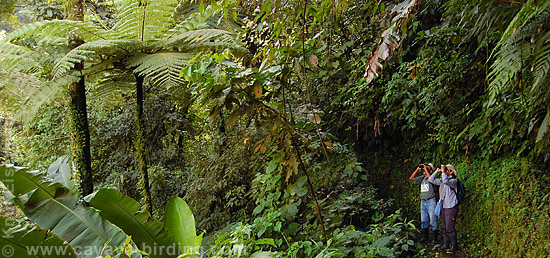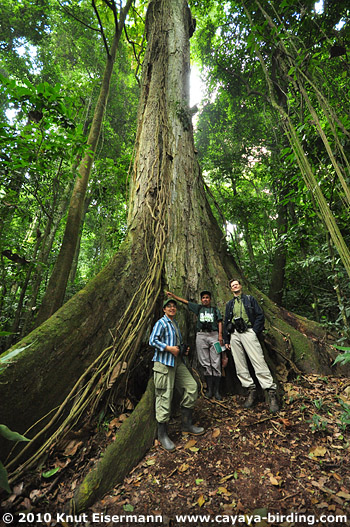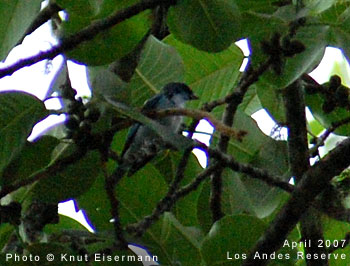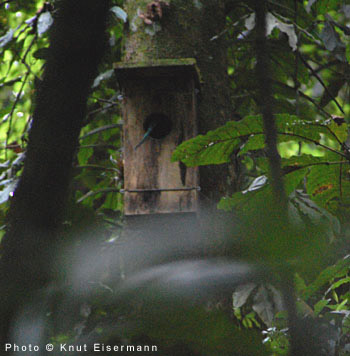Los Andes Reserve
Los Andes Reserve is part of a network of private nature reserves conserving forests on the southern and eastern slope of Atitlán volcano. Cloud forest at an elevation between 1,400 and 1,800 m (4,590-5,900 ft) is the keystone habitat at Los Andes.

Very humid cloud forest on the Guatemalan Atlantic slope mountains is the core habitat for Resplendent Quetzals in the country. Appropriate quetzal habitat is less extensive along Guatemala's volcanic belt on the Pacific slope, but Los Andes is a site where these birds are easily seen. Los Andes was the first site in Central America designated as a nature reserve for the protection of quetzals. Conservation efforts for this local quetzal population have been invested since the end of the 1960ies (Bowes & Allen 1969, LaBastille et al. 1972, LaBastille 1973, 1974, 1976, LaBastille & Pool 1978). The forest remained untouched and nest boxes were provided to face an assumed lack of natural nesting trunks. Quetzals need half rotten trunks to dig their nest holes, where they lay their eggs. Some of the pairs have indeed nested in the artificial boxes. Forest rangers are monitoring nesting and feeding sites. A hide near a favorite fruit tree on the forest edge allows the observation of foraging quetzals during certain months.
Azure-rumped Tanagers was recorded for the first time at Los Andes in 2000 (M. Centeno in Eisermann & Avendaño 2006). Later, PROEVAL RAXMU Bird Monitoring Program studied the distribution and natural history of this bird (Eisermann et. al 2011a,b). This species is endemic to the Pacific slope mountains of Guatemala and Chiapas, Mexico. Forest rangers identified the tanager's favorite fruit trees where birdwatchers have a good chance to see them. Other endemics of the northern Central American highlands observed during a visit in April 2007 include Highland Guan, Blue-throated Motmot, Green-throated Mountain-gem, and Bar-winged Oriole.
The cloud forest at Los Andes is accessible on an easy to walk loop trail of about 2.5 km ranging in elevation from 1,400-1,700 m (4,590-5,580 ft). Overall, the forest along the trail offers an interesting assemblage of lowland and highland bird species; e.g. both wood-wrens, White-breasted and Gray-breasted were recorded during a short visit in April 2007, as well as three species of motmots: Blue-crowned, Tody, and Blue-throated Motmot.
We recorded 59 bird species along the cloud forest trail on 4 April 2007. Most abundant species were Common Bush-Tanager, Paltry Tyrannulet, Golden-crowned Warbler, Brown-backed Solitaire, and Swainson's Thrush. Other species with at least five recorded individuals were Spotted Wood-Quail, Highland Guan, Collared Trogon, Rufous-and-White Wren, White-eared Ground-Sparrow, Wilson's Warbler, Slate-throated Redstart, White-faced Quail-Dove, Emerald Toucanet, Eye-ringed Flatbill, Barred Parakeet, Scaly-throated Foliage-gleaner, Resplendent Quetzal, Blue-crowned Chlorophonia, Chestnut-capped Brushfinch, Elegant Euphonia, Hooded Grosbeak, Spotted Nightingale-Thrush, Violet Sabrewing, and Gray-breasted Wood-Wren. Most noteworthy record was a Barred Forest-Falcon, a rare species on the Guatemalan Pacific slope and the first record for the Atitlán volcano.
Los Andes has trails among a mosaic of different plantations (coffee, tea, macadamia, quinine) and forest fragments, ranging in elevation from 850 m to the edge of the cloud forest at 1400 m. During our visit in April 2007 we focused on the upper area, where Rufous Sabrewing, Prevost's Ground-Sparrow, Western Tanager, Pacific Parakeet, Bushy-crested Jay, Plain Wren, Yellow-winged Tanager, Swainson's Thrush, and Cedar Waxwing were common.
Access and accommodation: Los Andes Reserve is accessible on paved and dirt road via Santa Barbara. All visits must be reserved in advance.
When is the best time for a visit to Los Andes? Any time of year. The nesting season of quetzals ranges from February to June.
How do you support conservation and development in Los Andes? As a private nature reserve Los Andes must meet requirements of the national law of protected areas in an autosustainable way. The tourism program provides not just additional income, but helps also to develop environmental awareness among the local population. A total of 55 families live at Los Andes. Local capacities are being developed, which enables local families to take responsibilities in the tourism program, e.g. transports by 4-WD vehicle to the edge of the cloud forest, preparing meals, and guiding. This development diversifies income alternatives of local people and strengthens the base to protect natural habitat on the long term. Los Andes is part of the Atitlan Important Bird Area (IBA GT015), designated by BirdLife International.


